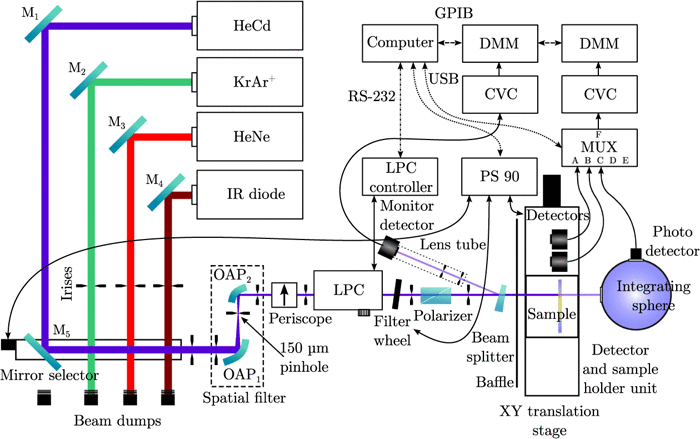UVIADEM project (2011-2015)
This joint project of Metrology Research Institute, Finnish Meteorological Institute, and Tampere Technical University studied ageing of materials and measurement methods for characterizing ageing. The main outcome was a set of test results obtained for polystyrene (PS) and polypropene (PP) aged for various time periods, in different geographical locations, in weather chambers, and at different orientations. The samples were measured for FTIR, color and rheology. For PS, also the wavelength dependent action spectrum was measured using a purpose-built spectrograph. The data can be used with meteorological data of the corresponding time periods to study differences in ageing.

The role of Metrology Research Institute in the project was to study spectrally the ageing of materials. A novel high-resolution transmittance measurement setup based on lasers was developed for measuring color changes, such as photoyellowing of translucent materials aged with a spectrograph [1]. The measurement setup includes 14 power-stabilized laser lines between 325 nm and 933 nm wavelengths. Measurement at various locations aged with different wavelengths of exposure radiation gives the transmittance data required for acquiring the action spectrum. The combination of a UV spectrograph [2] and the new high resolution transmittance measurement setup enables a novel method for studying the UV-induced ageing of translucent materials with a spectral resolution of 3 – 8 nm, limited by the adjustable spectral bandwidth range of the spectrograph. These achievements form a significant improvement over earlier methods.
Improved methodology for deriving action spectrum of photoyellowing induced by UV radiation on a polymeric material was developed [3]. The methodology was tested on newspaper samples, the yellowing of which was quantified by post-exposure color measurements. The analysis accounts for the logarithmic temporal behavior of the property change and yields a generic material specific action spectrum for photoyellowing. This model describes many changes better than linear models often used. Methodology was also developed and reported for accounting time and intensity of exposure in deriving the action spectra. Effects of temperature on the action spectra were studied.
Characterizing the optical methods used resulted in interesting by-products, such as a temperature controller for high power light emitting diodes based on resistive heating and liquid cooling [4]. Also a spectrally adjustable quasi-monochromatic radiance source based on LEDs was developed [5]. This device can be used e.g. for measuring spectral responsivities of luminance meters or cameras.
Contact persons: Petri Kärhä and Anna Vaskuri
References
[1] A. Vaskuri, P. Kärhä, A. Heikkilä, and E. Ikonen, “High-Resolution Setup for Measuring Wavelength Sensitivity of Photoyellowing of Translucent Materials,” Rev. Sci. Instrum. 86, 103103 (2015).
[2] P. Kärhä, A. Heikkilä, K. Ruokolainen, and M. Kaunismaa, “A novel facility for ageing materials with narrow-band UV radiation exposure,” Rev. Sci. Instrum. 82, 023107 (2011).
[3] A. Heikkilä and P. Kärhä, “Photoyellowing revisited: Determination of an action spectrum of newspaper,” Polym. Degrad. Stab. 99, 190–195 (2014).
[4] H. Baumgartner, A. Vaskuri, P. Kärhä, and E. Ikonen, “A temperature controller for high power light emitting diodes based on resistive heating and liquid cooling,” Appl. Therm. Eng. 71, 317–323 (2014).
[5] J-M. Hirvonen, T. Poikonen, A. Vaskuri, P. Kärhä, and E. Ikonen, ”Spectrally adjustable quasi-monochromatic radiance source based on LEDs and its application for measuring spectral responsivity of a luminance meter,” Meas. Sci. Technol. 24, 115201 (2013).
- Published:
- Updated: